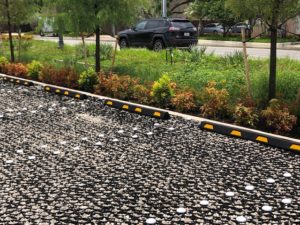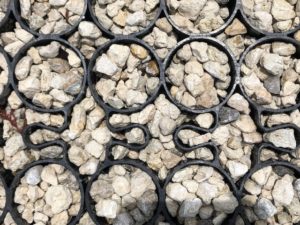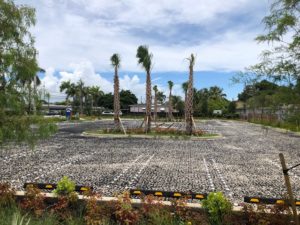31 May Semi-permeable Parking Lots: Mitigating the Effects of Climate Change
 The reality of climate change is evident in the increasing prevalence of flooding in our cities. Urban development results in more and more concrete and fewer places for water to drain away during storms. As we remove wetlands and other natural geological features that absorb rainwaters, we leave our cities exposed to serious flooding problems as storm sewers cannot keep pace. Semi-permeable construction materials, such as pavers used in parking lots offers one option to mitigate the problem.
The reality of climate change is evident in the increasing prevalence of flooding in our cities. Urban development results in more and more concrete and fewer places for water to drain away during storms. As we remove wetlands and other natural geological features that absorb rainwaters, we leave our cities exposed to serious flooding problems as storm sewers cannot keep pace. Semi-permeable construction materials, such as pavers used in parking lots offers one option to mitigate the problem.
Unlike asphalt and concrete surfaces, both of which easily succumb to the stresses of weather, Permeable pavers utilize a porous surface, which allows rainfall to naturally drain through to the subsurface. The pavers also produce less runoff which erodes surface materials and carries water and pollutants to nearby soil and gardens. The pavers allow the water to refill local aquifers more slowly and naturally and require minimal maintenance as opposed to conventional drain systems. The pavers also cost significantly less to install and maintain. With no permanent footprint or fixtures, they can be removed quickly and inexpensively as needed.
 In Hallandale Beach, the Community Redevelopment Agency (HBCRA) addressed the critical challenge of flooding for a newly constructed parking lot at 203/207 NE 3rd St. The semi-permeable lot mitigates water overflow and provides space for approximately 50 vehicles. Also, the structure is impermanent and can be dismantled to accommodate alternative parking structures to meet future demand. The total cost of the semi-permeable parking lot was less than half a million dollars. This encompassed construction of a sustainable parking lot with pervious surfaces, bio-swales and native plantings on a 0.51 acre vacant lot. The parking lot’s low impact design (LID) consists of a dust‐free permeable paving system, sidewalks, concrete curb, parking lot lighting, swale construction, landscaping, and irrigation improvements. A new concrete sidewalk, curb and gutter, and reconstruction of the swale on NE 2nd Avenue are also included.
In Hallandale Beach, the Community Redevelopment Agency (HBCRA) addressed the critical challenge of flooding for a newly constructed parking lot at 203/207 NE 3rd St. The semi-permeable lot mitigates water overflow and provides space for approximately 50 vehicles. Also, the structure is impermanent and can be dismantled to accommodate alternative parking structures to meet future demand. The total cost of the semi-permeable parking lot was less than half a million dollars. This encompassed construction of a sustainable parking lot with pervious surfaces, bio-swales and native plantings on a 0.51 acre vacant lot. The parking lot’s low impact design (LID) consists of a dust‐free permeable paving system, sidewalks, concrete curb, parking lot lighting, swale construction, landscaping, and irrigation improvements. A new concrete sidewalk, curb and gutter, and reconstruction of the swale on NE 2nd Avenue are also included.
 The semi-permeable parking lot addressed several problems. The obvious problem was space – it created 50 new parking spaces to accommodate the inflex of visitors expected to visit the new Food, Fashion, Art, and Design District in the coming 2 – 3 years. But equally important in the City is the ongoing issue of flooding. Hallandale Beach is not only on the Atlantic Ocean, it is geographically situated in South Florida, a climate known for heavy raining seasons. The fact that South Florida is increasingly saturated with concrete and asphalt developments, the water from heavy downpours and storms has fewer places to adequately drain. This lot will mitigate the presence of large puddles and impassable side streets in such conditions. It will save the City costs in maintenance for its duration. Finally, the lot is impermanent, which makes it conveniently future-ready for removal should an alternative and much larger parking structure be required to accommodate increased demand (e.g. a multi-story garage).
The semi-permeable parking lot addressed several problems. The obvious problem was space – it created 50 new parking spaces to accommodate the inflex of visitors expected to visit the new Food, Fashion, Art, and Design District in the coming 2 – 3 years. But equally important in the City is the ongoing issue of flooding. Hallandale Beach is not only on the Atlantic Ocean, it is geographically situated in South Florida, a climate known for heavy raining seasons. The fact that South Florida is increasingly saturated with concrete and asphalt developments, the water from heavy downpours and storms has fewer places to adequately drain. This lot will mitigate the presence of large puddles and impassable side streets in such conditions. It will save the City costs in maintenance for its duration. Finally, the lot is impermanent, which makes it conveniently future-ready for removal should an alternative and much larger parking structure be required to accommodate increased demand (e.g. a multi-story garage).
The costs to construct semi permeable parking lots are comparable with traditional asphalt and concrete designs. The long-term advantages lie in less maintenance, environmental sustainability, and impermanence. Cities should strongly consider this approach based upon weather conditions and flooding issues. In addition, the semi-permeable lot is an excellent solution for parking in situations where the same land may take on different uses in the future. In this sense, the semi-permeable lot can be easily dismantled and removed. These lots can fit into just about any type of spatial requirement from small to large and irregularly shaped.
As changing weather patterns continue to affect different parts of the country (and the world) we need to be ready to take big and small steps to mitigate the impacts. While semi-permeable parking lots may not seem that glamorous, they are clearly a small step in the right direction.


